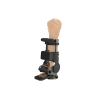Muscle strength measuring device
Technology description
| The name of the technology: | Muscle strength measuring device |
|---|---|
| Challenge: |
Muscle strength is a key marker of physical fitness and biological age. With an ageing population and emphasis on seniors' independence, this field is growing rapidly with strong market potential. Conventional hand dynamometers have major limitations — results depend on the patient’s understanding, motivation, and cooperation. This is especially problematic in seniors, children, or people with cognitive or neurological impairments. Measurements are often subjective and unreliable over time. Fatigue, pain, or depression can further distort results. These tools measure only hand strength, not total muscle capacity or lower-limb strength — crucial for assessing fall risk. They detect major strength loss but miss early decline, limiting their preventive use. Our device measures strength objectively, repeatedly, and independently of patient motivation, greatly expanding its use in clinical, preventive, physiotherapy, and home settings. |
| Description: |
The lack of quantitative objective data on muscle strength measurement led to the development of our device. Our solution is a device that measures muscle strength independently of the will and involvement of the person being measured. The device works on the principle of electrical stimulation of the musculus tibialis at the motor point, with a series of stimulations increasing in intensity. The device uses standard commercially available electrostimulation devices with electrodes that are single-use and are always applied to the skin at the motor point of the muscle. The foot is fixed in a splint during the measurement, where a sensor measures changes in the force moment. The strength of the muscles is then calculated from the measured values, and the device is capable of measuring the strength of slow and fast muscle fibres separately with an error margin of less than 6%, as determined by repeated measurements on more than 200 subjects. Current commercially available devices for measuring muscle strength are based on a dynamometric principle that requires active participation of the test subject. This approach is limited by low sensitivity, high variability of results and dependence on external factors such as the time of day, motivation or cognitive state of the patient. These limitations significantly restrict their usefulness, particularly for patients in intensive care, geriatric patients or individuals with limited ability to cooperate. Our technology addresses this issue by measuring muscle strength objectively, passively, and independently of the patient's conscious will. This brings a significant innovation not only to the fields of sports and rehabilitation medicine, but also opens up new possibilities in the areas of intensive care and hospital monitoring (e.g. for long-term immobile patients) and in the rapidly growing longevity and personalised health sector. The mobility, simplicity and ease of use of the device allow it to be used in a domestic environment or in the fitness sector, It can be used as a tool for preventing injuries, improving performance or monitoring biological age and the functional reserve of the muscular system. |
| Commercial opportunity: |
The market size for medical dynamometers was estimated at 860 million USD in 2024, with an expected CAGR of 6.5% between 2025 and 2032. Market growth is driven primarily by an increasing incidence of sports injuries, orthopaedic and neurological diagnoses, as well as growing demand for diagnostic and monitoring systems for an ageing population. For example, there are 2 million sports injuries among high school students in the USA every year, with tens of thousands requiring hospitalisation. Our target segments include rehabilitation and sports medicine, as well as the growing longevity and healthspan technology market, which includes home self-monitoring, anti-aging clinics, and personalised care focused on maintaining physical autonomy in old age. Thanks to its technical design, the device has the potential to become a standard tool for monitoring functional health across age and clinical groups. In combination with other biomarkers, it can serve as a basis for sophisticated patient stratification, injury prevention, early detection of sarcopenia, or evaluation of the efficacy of therapeutic interventions. |
| IP protection status: | Patent application in preparation. |
| Development status: |
Phase 2Corresponds with TRL 3 and TRL 4 Feasibility study. There is a realistic design of the technology and the initial tests in the laboratory are leading to the specification of the technology requirements and its capabilities.
|
| Partnering strategy: | Co-development Collaboration investment licensing |
| More information: | |
| Images: | |
| Categories: | Medical Devices Diagnostics Sports & Recreational activities |
| Institution: | Fakultní nemocnice Hradec Králové |
| Owner of a technology: | University Hospital Hradec Králové |
